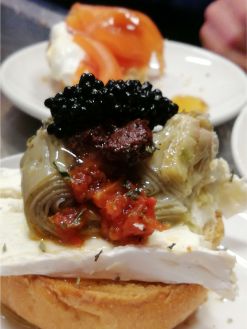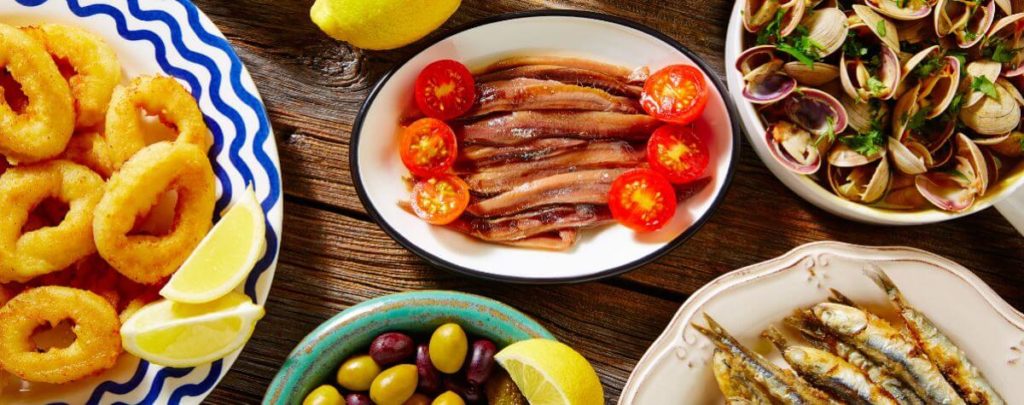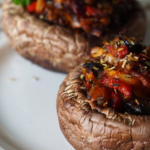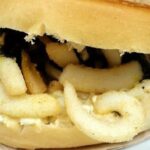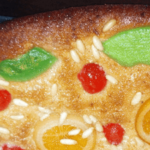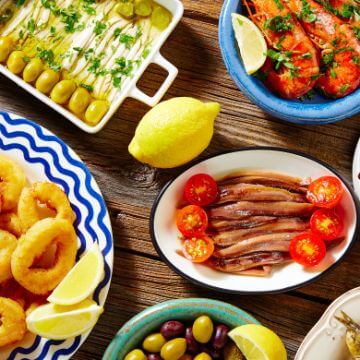
What Food is Barcelona Famous For?
THE TRADITIONAL FOOD IN BARCELONA YOU MUST TRY
Barcelona is a foodie destination. The Catalan cuisine sprouts out of a rich landscape that includes sea, countryside, marshals and woods. Our soft climate favors light dishes, but still leaves room for earthy winter recipes. Our history has weaved connections with the neighboring cultures. Our food receives Spanish, Italian, French and Mediterranean influences.
Barcelona people are proud of their food legacy, but aren’t afraid to adopt other Spanish legacies to feast their palates. My list of traditional food of Barcelona might not please the purists, because I’ve included many items that come technically beyond the Catalan borders.
What food is Barcelona known for all year around?
1
Pa amb tomàquet
Tomato bread, sometimes written à la spanish as “pamtomaca”, is a specialty similar to Italian bruschetta. It’s par excellence the Catalan way of eating bread. No bread & butter for us. Give us a slice of bread or toast and a ripe tomato cut in half, so we can rub it on the bread. Garlic slightly rubbed before the tomato is optional (and only works on toast). Olive oil sprinkled on it is a must. Salt is optional.
We eat it just plain like that, or in sandwich form, or with a variety of toppings going from omelet to Spanish ham, cheese, anchovies or escalivada roasted veggies. You’ll often be offered it at tapas bars and Catalan restaurants. In some cases, they’ll bring you the toast and a basket of tomatoes and garlic, so you can make your own.
2
Paella and other rice dishes
You’ll find paella restaurants along the beach and the port. The most popular is the seafood paella, but you’ll also find meat paella, “mixta” paella (a combination of meat a seafood), “bogavante” lobster paella, vegetable paella… The paella “del senyoret” or Parellada is a seafood paella with no shells – great for lazy eaters. Avoid “Paellador”: it’s frozen and reheated paella.
If you’ve already tried paella before, go daring and try arròs negre, a black rice made with squid ink.
3
Fideuà
I know, I’m a cheater: Fideuà isn’t Catalan either. It also originated in the Valencia area: according to the legend it was a cook in Gandia who had the idea of swapping rice by noodles. But in Barcelona you can find great fideuà, and locals love it too.
This dish is similar to a seafood paella with noodles instead of rice, and it’s eaten topped with aioli garlic sauce. You’ll find it in most paella restaurants. But unlike paella, this dish doesn’t admit many variations. To the max, you’ll occasionally find a vegetarian version of it.
4
Bombas
You can also find it in many tapas bars. And there’s one that is a destination for bomba lovers: La Bombeta. They can serve over 1000 of them in a day.
5
Croquettes
What makes them fun is that they admit an infinity of flavors. The most common are chicken, ham, cheese, spinach and mushrooms. Most tapas bars serve at least one variety. And some bars specialize in them and feature the most incredible flavors. That’s the case of Catacroquet in Poblenou or Croq & Roll in Gracia.
6
Patatas Bravas
An unmissable of tapas bars, locals pilgrim to some bars famous for their bravas, such as Tomàs in Sarrià.
7
Spanish Omelet
It’s the star of any informal party or gathering that includes food, and it’s served in any local tapas bar. We love the one in Bar Lalans, but the ones in El Quim de la Boqueria and Cal Pep are spectacular too. If you love omelets, there’s two omelet bars you need to try, too: La Ceba and Flash Flash. And if you can’t wait, in this post I teach you how to make Spanish omelet.
8
Spanish Ham, Chorizo and other cold cuts
Most tapas bars will serve Jabugo ham platters or ham “pintxos” (slice of bread topped with ham). But you can also buy some in a local food market. Chorizo and other charcuteries are harder to find in bars and restaurants unless they make part of an assorted platter. But you can instead find quite easily fried chorizitos (small chorizo sausages).
9
Codfish
And that made it one of the few fish that was available in the countryside when travel was slow with horse carriages. And because fish was the alternative to meat during Lent and most Thursdays, cod became a very popular fish in Catalonia. As a result, in Catalonia we have hundreds of recipes for a fish that is not local.
10
Butifarra sausage with white beans
Pinotxo and El Quim, both in La Boqueria Market, usually have it. Cal Pep serves it with foie. And if you are not a fan of beans, the butifarra sausage from Bar la Plata is great.
11
"Callos" tripe
you’ll learn that Catalonia has its own ways to cook tripe. And that her grandmother already sold it decades ago in that same shop.
If you are lucky enough to stay in an apartment where you can cook, Rosa sells callos made by herself and vacum-packed so you only need to heat them before eating. You’ll also find them in Pinotxo (Boqueria Market), Bar Gelida, l’Univers (near Santa Caterina Market) or Bar Brusi.
12
Capipota
Maybe I should have skipped Callos altogether to avoid the controversy with Madrid, and just recommend one really Catalan offal recipe? In any case, here it is: Capipota is an earthy stew that consists of veal head and trotters.
Rosa usually has it also ready to go at her offal stall. Again, Bar Gelida and Pinotxo are two addresses that never fail.
13
Snails
Many market bars serve them. But if you are daring enogh, head to a specialty bar such as El Cargol and El Racó Del Cargól.
14
Escalivada
15
Anchovies
So of course anchovies are popular here! Most tapas bars and vermouth bars serve them, sometimes in combination with olives and other preserves. Xampanyet in El Born is my go-to place.
16
Squid and cuttlefish chipirones
Cuttlefish or sepia is the largest, and is usually served grilled. When it’s small cuttlefish, you’ll see it in the menu as “sepiones”. You might also occasionally see it as part of more elaborated earthy dishes such as “mandonguilles amb sepia” (meatballs with cuttlefish).
Squid is calamar in both Spanish and Catalan. If it’s grilled, it’s usually the full animal, smaller than a sepia. You can also see it “en su tinta”, served with its own ink. Calamari rings are “calamares a la romana”. Chipirones are deep-friend battered baby squid. And rabas are fried slices of the head of the squid.
All of these are very common in tapas bars, paella restaurants and marisqueria seafood restaurants. Cerveseria Catalana is a safe bet for them.
17
Local pastries: Xuxos, Ensaïmada, Coca...
It’s served as dessert on special occasions such as Saint John’s eve (June 23rd), or any given Sunday. But it also makes a great breakfast or merienda (afternoon snack).
Ensaimada is a roll from Mallorca (but very common in Barcelona) whose main ingredient is pork lard. In the island you find it stuffed with a variety of ingredients, but in Barcelona it’s mostly either plain or with cabell d’angel spaghetti squash jam. Forn Mistral and Formentor are two famous places to try it. Occasionally served as dessert, it’s more common as breakfast or merienda.
And xuxo is a sweat from Girona (1.5 hours North of Barcelona), that is like a croissant stuffed with cream, deep-friend then coated in sugar. Bar Pinotxo gets theirs from Forn Lys in El Raval. It’s a breakfast or merienda thing.
18
Desserts: Mel i Mató, Crema Catalana...
In some restaurants they serve recuit, another cottage cheese similar to mató.
Crema Catalana is the Catalan version of the French crèm brûlée. The main difference is that the Catalan dessert adds lemon or orange rind and cinnamon, while the French one is flavored with vanilla and often come kind of liquor, plus it often incorporates cream.
If you can’t find them in restaurants, both desserts can be found in La Pallaresa café on Petritxol street, where they also serve Mató de Pedralbes, a rich custard made with mató and eggs by the nuns of the Pedralbes monastery.
19
Wines and Cavas
And we are so proud of our wines, that most restaurants carry a majority of Catalan wines, with some Spanish additions. Only high end restaurants carry foreign bottles from France, Italy or overseas.
It’s hard to recommend a particular brand, because there are so many cellars that they rarely repeat from one restaurant to another. But if you like red wine, go for Priorat or Montsant region wines. If you like whites, Penedès, Alella or Empordà are good choices – and their rosés are great as well.
Cava is the Spanish version of Champagne. It’s produced following the same procedures, the Méthode Champenois, but we are not allowed to call it Champagne because it’s not produced in France. The word cava refers to the product as well as the cellar where it’s aged. And over 90% of the entire Spanish production of cava is made in the Penedes region. In this post you’ll find some of my favorite cava brands.
20
Beer
Cheap wine isn’t popular anymore, and better quality wine is reserved to restaurant outings, weekends or celebrations. Instead, beer’s popularity has grown and it’s often a choice for informal meals, specially in the Summer, as well as (not formal) restaurant outings, tapas and all kind of social events.
Every region of Spain has its own local brands, that are not commonly found in other areas (except for maybe large supermarkets). In Barcelona there’s three of them: Estrella Damm, San Miguel and Moritz. Plus a few dozens of small craft beer producers, which are often carried by tapas bars and local beer bars.
21
Vermouth
The food involved will be light: chips, olives, maybe cubes of potato omelet or a shared dish of Russian salad… And the drink adults order is vermouth, often with added soda and adorned with an olive or slice of lemon. It’s normal to order something else rather than vermouth, too. Wine, beer, coke, but we still say we are going for a vermouth.
Famous food in Barcelona to eat in Spring
22
Easter Mona
Spring is a discreet food season in Barcelona. Early Spring might still offer you the opportunity to taste Winter specialties, and late Spring is often already open for Summer foods. But there’s not much food specific to the Spring season.
If there’s one want to discuss, it’s the Easter Mona. On Easter Monday, godfathers buy their godchildren a Mona cake. Traditionally it was a simple dough decorated with boiled eggs and sugar.
Typical food in Barcelona to eat in the Sumer
23
Esqueixada and Empedrat
Summer is a time for light healthy food. Esqueixada and Empedrat are two Catalan Summer salads that refresh your palate and nourish your body. Both are based on salted cod, desalted and shredded.
The cod is served together with chunks of red ripe tomato and onion slices, and optionally green or black olives, hard boiled egg or green and red bell pepper. Some might decorate it with anchovies as well. Add olive oil and a dash of black pepper, and you got your Esqueixada.
24
Gazpacho
Gazpacho is a Summer drink that is hard to find the rest of the year, but it appears in lots of menú del día specials and starters menus as soon as the heat starts. Locals make gazpacho at home or buy ready-made gazpacho in their local supermarkets: usually they fill entire refrigerators with them in the fresh produce asiles.
25
Sangria
That’s why it’s hard to find in restaurants during the rest of the year. But in the Summer you’ll find it in most tapas and paella restaurants. My favorite is the one served at Bubo Bar in El Born. And if you can’t wait, here is my authentic sangria recipe.
26
Orxata
Orxata or Horchata is a popular non-alcoholic Summer drink that is not so well known by visitors. Unlike the Mexican version, Spanish horchata is not made with rice but with tiger nut from the Valencia area. It’s white but it doesn’t taste like milk at all: it’s a love it or hate it flavor.
You can find it in most gelato shops and many bars carry it also during the Summer months. You can also buy bottles in local supermarkets (make sure to get it from the fridge: cold is much better than room temperature). Or you can go to one of the specialty orxateries in Barcelona, that serve it all year around.
Famous food of Barcelona to eat in Autumn
27
Mushrooms
At the same time, the Barcelona restaurants will start serving them in a variety of preparations.
Grilled redcap “rovellons“, mushroom paella, scrambled eggs with mushrooms… The local markets also offer a plethora of mushroom varieties as well. Rovellons are expensive and difficult to find out of season. But cultivated mushrooms are now available all year around. The creamy mushrooms in Cerveseria Catalana, the mushroom mix of Bar Universal in La Boqueria or the fried eggs with mushrooms of El Quim de la Boqueria are supreme.
28
Panellets and roasted chestnuts
They are adorned with pine nuts, ground almond, cocoa, coconut and candy fruit. And often people make their own panellets to offer to their loved ones.
This time of the year you’ll also see small stalls scattered around the city where vendors roast chestnuts and sweet potatoes. Approach one of them (there’s usually one in the crossing of La Rambla with Cardena Casañas and Carrer de la Boqueria) and order a “paperina” paper roll of chestnuts. Now you are officially a real Barcelonan!
Typical food of Barcelona to eat in the Winter
29
Calçots with Romesco sauce
Calçots are grilled until completely black outside, then you peel them and dip them in a nutty “romesco” sauce. It’s a quite messy experience, but it’s lots of fun when you eat it with friends. Locals will organize private parties to enjoy them with friends and relatives, or head to farmhouse restaurants out of town that specialize in them.
They aren’t that easy to find in the city, but you’ll thank me for this list of calçot restaurants in Barcelona.
30
Churros with Hot Chocolate
Top it with whipped cream for extra richness – that’s what we call a “swiss”. Here are my favorite Barcelona hot chocolate places.
Not much more to add, except that purists will tell you that churros aren’t a Barcelona thing and that here we dip melindros sponge cakes. That’s OK. I also tell you where to find them in the post I linked before. All set!
31
Escudella
Winter is a time for earthy soups, and the Catalan earthy soup par excellence is Escudella. A mix of pasta, beans, veggies and meat leftovers, it’s sure to restore your body to a pleasant heat and energize you to continue sightseeing.
Traditional Catalan restaurants will include it in their winter starters as Escudella Barrejada. But on Christmas day locals will eat a richer version of it, where the beans, veggies and meats are served separately after the soup as the main course. That’s Escudella i Carn D’Olla.
32
Cannelloni
This Italian dish adopted by the Catalans isn’t exclusively eaten that day, but also in a lot of other celebrations such as Saint Joseph day or on Sundays. And many typical Catalan restaurants carry them all year around. You can find them in the deli section of Pastisseria Mauri, or buy them to go in the bean stalls of La Boqueria.
33
Turron and other Christmas treats
Turron is the most popular Christmas treat in Spain. It is made of ground almonds and sugar or honey, although there are more varieties of turron that incorporate also chocolate, coconut, candy fruit and whatever else. From December to the end of January, you can buy it in any supermarket, but industrial turron can’t beat the artisan one sold in specialty turron stores.
Marzipan, neules and polvorones are other typical Christmas sweets you cand find both in supermarkets and specialty stores. They are rarely served in restaurants.
34
Xatonada
It’s made with escarole, alberquina olives, anchovies and shredded cod and tuna. Some might also add a baked onion. And dressed with xato sauce, a close cousin of romesco. What makes it a winter salad is that escarole is a winter green, and it doesn’t include Summer veggies such as tomato or peppers.
You’ll often find xatonada as a starter in Catalan restaurants as well as paella restaurants but mostly only in the Winter.
35
Closing the loop... Lent specialties
The end of Winter usually coincides with Lent, the 40 days Catholic observe before Easter. It’s a time when you are supposed to fast or at least deprive yourself of rich foods and meats. Fat Thursday is your last opportunity to indulge, and that’s when locals eat egg sausage omelets.
El Quim de la Boqueria serves them just that precise day. Or you can buy it all year around in butcher shops. My favorite is the specialty sausage store Butifarreria de Santa Maria in El Born. Egg sausage is a cooked specialty that can be eaten as it is sold. No need to cook or heat it, so you can go for it even if you aren’t staying in an apartment with kitchen.
Cod fish plates are typical of this time of the year, even if you can find them all year around. In baked “a la llauna” in garlic oil, cooked in “samfaina” ratatouille sauce, made as bunyols fritters… Most Catalan restaurants include at least one of its forms in their menus. And cod fritters are commonly found in tapas bars.
What's your favorite Barcelona famous food?
Marta
MORE BARCELONA TIPS FOR YOU:
SHARE WITH YOUR TRAVEL MATES
RESEARCHING FOR A TRIP IS TIME-CONSUMING…
Need more inspiration?
Our 100% FREE Barcelona Collection will give you everything you need to organize the trip of your lifetime to Barcelona.
BEST INSIDER TIPS FROM THE PROS!
